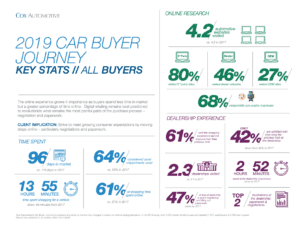When a customer walks into your showroom, what are they looking for? What do they expect as far as their customer experience, and how can you help them find the car they need? Due to the impact of technology and a greater emphasis on convenience and flexibility, consumer tastes are rapidly changing. This event requires all businesses to continuously re-examine their approaches to customer service, operations, and marketing.
One of the best ways to do this is to keep up on industry stats and customer data. Each year Cox Automotive releases data on the current state of consumer tastes in the automotive industry. Below are takeaways based on recent data regarding what customers are looking for in the dealership experience, and how they are navigating their car buyer journey.
Used Vehicles are Poised to Dominate the Market
Cox Automotive surveyed over 3,000 customers, and a majority of these individuals (64 percent) indicated that they would either purchase a used or primarily used vehicles. The survey also revealed that new vehicle payments had increased twice that of used cars.
The Takeaway: This rising cost of new cars and the resulting preference for used cars is going to require that dealers make recent car model trade-ins, and the selling of used vehicles a marketing and branding priority over the next couple of years.
Customers Prefer Using Third-Party Websites to Search for Cars
Compared to 2017, the number of consumers using the internet to search for vehicles rose four percent (57 percent to 61 percent respectively). While these customers are online, they are most likely visiting third-party websites to research new or used vehicles. Eighty percent of vehicle buyers visit a third-party site. These websites are also the most influential sites in driving dealership visits.
The Takeaway: It isn’t enough to only update a dealership inventory page. Dealers should partner with third-party sites and post vehicles there as well. It can be the difference between increasing leads or staying stagnant in the customers they currently reach.
The Source of The Information Depends on What Customers are Looking For
While third-party sites are widely used, dealership and OEM sites still have crucial purposes for customers. Cox Automotive found that third-party websites are used to gain “unbiased information during the selection process.” However, when a customer knew the specific type of car they wanted, they went to the dealership website. Lastly, customers who were looking for particular car features or incentives and offers went directly to the OEM website.
The Takeaway: Knowing this data can allow dealers to capitalize on what they have by putting the right information in the best places. Customers who are still on the fence about what they want can find a car on a third-party site. However, when they finally move through the sales funnel and make a decision about the specific vehicle they want, then the dealership website is where the customers will go. An innovative dealership should ensure they have a customer sales funnel as well as methods for tracking where leads are coming from to capitalize on these customer decisions.
Vehicle Specifications are the Top Reasons for a New Car Purchase
While reputation (28 percent) and deals (22 percent) come in second and third respectively when it comes to new car purchases, vehicle specifications (38 percent) are the top reason for why customers select the new vehicle that they do. Ultimately, customers will put customizations and preferred features for a new car over the make’s reputation or even the price.
The Takeaway: Used vehicle customers are likely swayed by price, while customers purchasing newer vehicles are more concerned with features and specifications. This finding makes sense as customers who still choose to buy a new car—even with prices steadily rising— are likely less price sensitive. Playing up the levels of customization, personalization, and technological features that accompany new cars can encourage more new vehicle sales. 
Customers are Still Unhappy with the Paperwork and Negotiation Process
For many of the years that Cox Automotive has run this survey, many customers have expressed concern with the F&I process. This year is no different as the top frustration for individuals is filling out paperwork and completing contracts for purchasing at 29 percent. The second most frustrating element is negotiating the price at 28 percent.
The Takeaway: It is understandable to keep parts of the negotiation and contract process offline. However, there may be ways to shorten the experience by allowing customers to get pre-approved for cars online, enter contact information into a form before their arrival, or even institute an efficient pricing model to drive down the time of negotiation. These tactics can be a win-win for the dealerships and customers as it betters the customer experience and allows dealerships to work with more customers in a shorter period of time.
Final Thoughts
As technology evolves along with consumer tastes, the wants and needs of customers will continue to grow and change as time goes on. Studies like the one conducted by Cox Automotive provides helpful insight into the mind of the customer. As a result, dealers can create strategies to prepare for the changing tastes to ensure their dealership is ready to meet their demands.
For more customer car buying insights, take a look at the 2019 Cox Automotive Car Buyer Survey.








